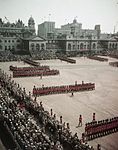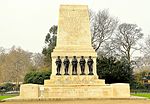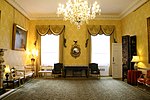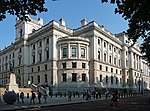Royal Naval Division War Memorial

The Royal Naval Division Memorial is a First World War memorial located on Horse Guards Parade in central London, and dedicated to members of the 63rd (Royal Naval) Division (RND) killed in that conflict. Sir Edwin Lutyens designed the memorial, which was unveiled on 25 April 1925—ten years to the day after the Gallipoli landings, in which the division suffered heavy casualties. Shortly after the war, former members of the division established a committee, chaired by one of their leading officers, Brigadier-General Arthur Asquith, to raise funds for a memorial. Progress was initially slow. The committee planned to incorporate its memorial into a larger monument proposed by the Royal Navy for Trafalgar Square. When the navy abandoned that project, the RND's committee decided to proceed independently. They engaged Lutyens, who, after negotiation with the Office of Works, produced a design for a fountain connected to the balustrade of the Admiralty Extension building. Lutyens' obelisk rises from a bowl, with water spouts projecting from sculpted lion heads at its base. The bowl is connected to a second, shallower basin by a decorative plinth. The base contains relief carvings of the insignia of units attached to the RND. As well as various dedicatory inscriptions, the base contains the division's battle honours and an excerpt from the poem III: The Dead by Rupert Brooke, who died of disease while serving in the division in 1915. The memorial was unveiled on 25 April 1925 by Major-General Sir Archibald Paris, the division's first commanding officer. Winston Churchill, the division's creator, gave a rousing speech praising Lutyens' design and the RND's record of distinguished service. The memorial was dismantled and placed in storage in 1939 to allow the construction of the Admiralty Citadel in the Second World War. It was re-erected in 1951, in the grounds of the Royal Naval College in Greenwich. When the college closed in the late 1990s, a campaign was established to move the memorial back to its original location, where it was unveiled in 2003; Churchill's grandson read out his grandfather's speech from the original ceremony. The memorial was designated a grade II listed building in 2008 and upgraded to grade II* in 2015, when Historic England declared Lutyens' war memorials a national collection.
Excerpt from the Wikipedia article Royal Naval Division War Memorial (License: CC BY-SA 3.0, Authors, Images).Royal Naval Division War Memorial
Horse Guards Road, City of Westminster Covent Garden
Geographical coordinates (GPS) Address Nearby Places Show on map
Geographical coordinates (GPS)
| Latitude | Longitude |
|---|---|
| N 51.505348 ° | E -0.129056 ° |
Address
Admiralty Citadel
Horse Guards Road
SW1A 2AQ City of Westminster, Covent Garden
England, United Kingdom
Open on Google Maps











